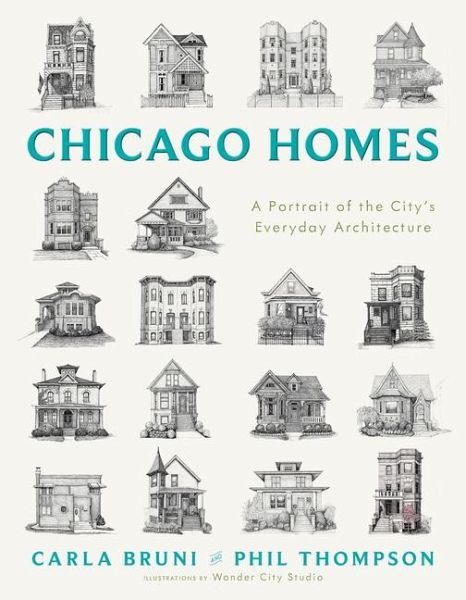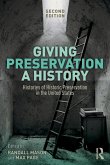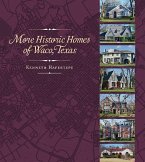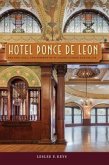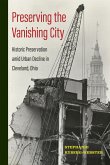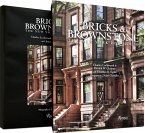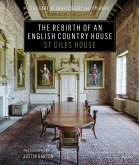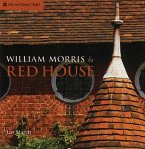31,99 €
inkl. MwSt.
Versandkostenfrei*
Erscheint vorauss. 7. Oktober 2025
Melden Sie sich
hier
hier
für den Produktalarm an, um über die Verfügbarkeit des Produkts informiert zu werden.

16 °P sammeln
- Gebundenes Buch
A comprehensive, first-of-its-kind book about Chicago’s residential architecture and the stories that shaped it. This is an entertaining and precisely illustrated story of Chicago homes from the city’s earliest days through the postwar era, revealing everything about what makes a home a Chicago home. A city famous for its architecture—and for arguing with New Yorkers about who built it first and best—now has a definitive guide to the unique housing types and styles that have inspired so much devotion. This book is for curious Chicagoans and visitors alike—anyone who’s ever wondered how to…mehr
Andere Kunden interessierten sich auch für
![Giving Preservation a History Giving Preservation a History]() Giving Preservation a History75,99 €
Giving Preservation a History75,99 €![More Historic Homes of Waco, Texas More Historic Homes of Waco, Texas]() Kenneth HafertepeMore Historic Homes of Waco, Texas36,99 €
Kenneth HafertepeMore Historic Homes of Waco, Texas36,99 €![Hotel Ponce de Leon Hotel Ponce de Leon]() Leslee F. KeysHotel Ponce de Leon28,99 €
Leslee F. KeysHotel Ponce de Leon28,99 €![Preserving the Vanishing City Preserving the Vanishing City]() Stephanie Ryberg-WebsterPreserving the Vanishing City38,99 €
Stephanie Ryberg-WebsterPreserving the Vanishing City38,99 €![Bricks & Brownstone: The New York Row House Bricks & Brownstone: The New York Row House]() Charles LockwoodBricks & Brownstone: The New York Row House73,99 €
Charles LockwoodBricks & Brownstone: The New York Row House73,99 €![The Rebirth of an English Country House: St Giles House The Rebirth of an English Country House: St Giles House]() Earl Of ShaftsburyThe Rebirth of an English Country House: St Giles House50,99 €
Earl Of ShaftsburyThe Rebirth of an English Country House: St Giles House50,99 €![William Morris & Red House: A Collaboration Between Architect and Owner William Morris & Red House: A Collaboration Between Architect and Owner]() Jan MarshWilliam Morris & Red House: A Collaboration Between Architect and Owner35,99 €
Jan MarshWilliam Morris & Red House: A Collaboration Between Architect and Owner35,99 €-
-
-
A comprehensive, first-of-its-kind book about Chicago’s residential architecture and the stories that shaped it. This is an entertaining and precisely illustrated story of Chicago homes from the city’s earliest days through the postwar era, revealing everything about what makes a home a Chicago home. A city famous for its architecture—and for arguing with New Yorkers about who built it first and best—now has a definitive guide to the unique housing types and styles that have inspired so much devotion. This book is for curious Chicagoans and visitors alike—anyone who’s ever wondered how to spot a Foursquare or where to find Italianate homes from before the Great Chicago Fire. Why are Chicago’s lots so narrow? How many Chicagoans built homes from a kit? What exactly is a “greystone”? The authors combine their decades of experience in historic preservation and illustration to create an evergreen resource that Chicagoans and visitors will turn to for answers to these and other questions about the city’s neighborhoods and the homes its citizens live in, visit, and admire.
Hinweis: Dieser Artikel kann nur an eine deutsche Lieferadresse ausgeliefert werden.
Hinweis: Dieser Artikel kann nur an eine deutsche Lieferadresse ausgeliefert werden.
Produktdetails
- Produktdetails
- Verlag: Agate Publishing
- Seitenzahl: 304
- Erscheinungstermin: 7. Oktober 2025
- Englisch
- ISBN-13: 9781572843578
- ISBN-10: 1572843578
- Artikelnr.: 72809723
- Herstellerkennzeichnung
- Libri GmbH
- Europaallee 1
- 36244 Bad Hersfeld
- gpsr@libri.de
- Verlag: Agate Publishing
- Seitenzahl: 304
- Erscheinungstermin: 7. Oktober 2025
- Englisch
- ISBN-13: 9781572843578
- ISBN-10: 1572843578
- Artikelnr.: 72809723
- Herstellerkennzeichnung
- Libri GmbH
- Europaallee 1
- 36244 Bad Hersfeld
- gpsr@libri.de
Carla Bruni has spent close to twenty years preserving, studying, and writing about historic architecture across dozens of US cities and four continents. She teaches graduate students at the School of the Art Institute of Chicago, where she holds a master of science degree in historic preservation. She has been a recurring guest discussing architecture and environmental issues on WGN Radio, and her work has been featured by StoryCorps Chicago, WLS, NPR, PRX, the Chicago Reader, Chicago Tonight, Chicago Magazine, and various national and international publications. She also works to support the 30,000+ members of the Chicago Bungalow Association, overseeing energy efficiency retrofits, creating history and home maintenance resources, and leading the charge to list thousands of vintage homes in the National Register of Historic Places. Her professional involvement in community repair and revitalization has taken her to every corner of Chicago, her native city. Phil Thompson is the cofounder and illustrator behind Wonder City Studio (wondercitystudio.com), a company dedicated to creating artwork of the places worth preserving, with a special love for Chicago. For ten years, he has captured more than a thousand homes and buildings with his pen-and-ink illustrations. His work has been featured in dozens of media outlets, including the Chicago Tribune, Chicagoist, Curbed, Business Insider, and Chicago magazine. Clients have included the University of Chicago, Northwestern University, and the Chicago Architecture Center, among others, and his prints are sold at seventeen retail locations throughout the city.
Foreword
Introduction
Chapter 1: Early Inhabitants, Early Homes 1780 to 1837
* Introduction
* Little Home on the River
* Homes of the French Colonial/Creoles
* The DuSable Home
* Homes of the Native Americans in the Region
* Early American Settlers: The Log Cabin
* The Making of the Chicago Grid
* New Town, New Gables Abound
* From Timber to Balloon Frame
* The Greek Revival Home
* The Clarke-Ford Home
* A City by 1837
Chapter 2: From Founding to Fire 1837 to 1871
* Introduction
* Homes for a Booming Metropolis
* Building Materials
* The Pre-Fire Homes Still with Us
* Interior Spaces in the mid-1800s
* Heating and Cooling, Lighting, Plumbing
* The Pre-Eminent Workers Cottage
* House Moving House Raising
* The Ornate Cottages and Rowhouses of Chicago (pre-1871)
* Italianate
* Second Empire
* Pre-Fire Homes in the Former “Suburbs”
Chapter 3: Rising and Rebuilding 1871 to 1882
* Introduction
* Fire Limits and Regulation
* Decline of Pine, Uptick of Brick
* Joliet Limestone, “Athens Marble”
* Post-Fire Patterns of Population Growth
* The Post-Fire Limits, Pre-Annexation Homes of the “Suburbs”
* Architecture as a Profession
* The Dominant Style of the Era
* The Brick Workers Cottage
* The Rise of “Flats” Buildings
* Two-Story and Wood-frame Italianates
Chapter 4: Annexation and Elevation 1882 to 1893
* Introduction
* Bold New Architecture in Chicago
* Raging Styles
* New Heights
* The Apartment Hotels and the First Courtyard Building
* Terra Cotta Finds Its Moment
* The Real Estate Developers
* Company Towns, Company Housing
* Annexation and the Changing Fire Limits
* City Lights, City Heats
* Italianate, continued
* Chateauesque
* Stick Style Shingle Style
Chapter 5: White City, Blight City 1893 to 1900
* Introduction
* The World’s Columbian Exposition
* Sidebar: Clarifying Windows
* Beaux Arts/Classical Revival
* Romanesque Revival (and Interment)
* Chateauesque
* Farewell to the Queen (Anne)
* Colonial Revival
* Greystones + Brick Flats
* Workers Cottages Just Keep on Working
* Sidebar: Working Class Domestic Life
* Courtyard Apartment Buildings
* Prairie Style
* American Foursquares
* Tudor Revival
* Sidebar: Coach Houses
Chapter 6: New Century, New Chicago 1900 to 1917
* Introduction
* Adapting The Workers Cottage
* Burnham’s 1909 Plan of Chicago
* Frame and Stucco Bungalows
* Chicago Bungalows
* Sears Home Catalogs
* Tudor Revivals
* Colonial Revivals
* Greystones
* Prairie Style Homes
* American Foursquares
* Bleak Housing Conditions and Tenement Reform
* Courtyard Apartment Buildings
* Brick Two-Flats and Variations on a Theme
* The Back Porch
Chapter 7: Death, Speed, and a Bit of Whimsy 1917 to 1929
* Introduction
* Chicago Bungalows
* Brick Two-Flats and Variations on a Theme
* Courtyard Apartment Buildings
* The “Own Your Own Home” Movement
* Tudor Revivals
* Colonial Revivals
* Spanish Revivals
* Foursquares
* Homes for Cars
* Art Deco
Chapter 8: Hard Times, New Deals, and a Century of Progress 1929 to 1941
* Introduction
* The National Mortgage Crisis
* Redlining
* Lingering Chicago Bungalows
* Tudor Revivals
* World’s Fair 1933
* West Burton Place and the Creative Response to the Depression
* Art Deco and Moderne
Chapter 9: Common Modifications to Homes: How We Really Live
* Introduction
* Dormer and Second Story Additions
* Enclosed Porches
* Metal Awnings
* Perma-Stone / Formstone
* Removing + Hiding Fireplaces and Stained Glass
* Vinyl Siding
* Glass Block + PIcture Windows
* Raised Workers Cottages
* Metal Hand and Porch Rails
* Street- or Courtyard- Facing Metal Balconies
* Overlord Additions
Epilogue
Introduction
Chapter 1: Early Inhabitants, Early Homes 1780 to 1837
* Introduction
* Little Home on the River
* Homes of the French Colonial/Creoles
* The DuSable Home
* Homes of the Native Americans in the Region
* Early American Settlers: The Log Cabin
* The Making of the Chicago Grid
* New Town, New Gables Abound
* From Timber to Balloon Frame
* The Greek Revival Home
* The Clarke-Ford Home
* A City by 1837
Chapter 2: From Founding to Fire 1837 to 1871
* Introduction
* Homes for a Booming Metropolis
* Building Materials
* The Pre-Fire Homes Still with Us
* Interior Spaces in the mid-1800s
* Heating and Cooling, Lighting, Plumbing
* The Pre-Eminent Workers Cottage
* House Moving House Raising
* The Ornate Cottages and Rowhouses of Chicago (pre-1871)
* Italianate
* Second Empire
* Pre-Fire Homes in the Former “Suburbs”
Chapter 3: Rising and Rebuilding 1871 to 1882
* Introduction
* Fire Limits and Regulation
* Decline of Pine, Uptick of Brick
* Joliet Limestone, “Athens Marble”
* Post-Fire Patterns of Population Growth
* The Post-Fire Limits, Pre-Annexation Homes of the “Suburbs”
* Architecture as a Profession
* The Dominant Style of the Era
* The Brick Workers Cottage
* The Rise of “Flats” Buildings
* Two-Story and Wood-frame Italianates
Chapter 4: Annexation and Elevation 1882 to 1893
* Introduction
* Bold New Architecture in Chicago
* Raging Styles
* New Heights
* The Apartment Hotels and the First Courtyard Building
* Terra Cotta Finds Its Moment
* The Real Estate Developers
* Company Towns, Company Housing
* Annexation and the Changing Fire Limits
* City Lights, City Heats
* Italianate, continued
* Chateauesque
* Stick Style Shingle Style
Chapter 5: White City, Blight City 1893 to 1900
* Introduction
* The World’s Columbian Exposition
* Sidebar: Clarifying Windows
* Beaux Arts/Classical Revival
* Romanesque Revival (and Interment)
* Chateauesque
* Farewell to the Queen (Anne)
* Colonial Revival
* Greystones + Brick Flats
* Workers Cottages Just Keep on Working
* Sidebar: Working Class Domestic Life
* Courtyard Apartment Buildings
* Prairie Style
* American Foursquares
* Tudor Revival
* Sidebar: Coach Houses
Chapter 6: New Century, New Chicago 1900 to 1917
* Introduction
* Adapting The Workers Cottage
* Burnham’s 1909 Plan of Chicago
* Frame and Stucco Bungalows
* Chicago Bungalows
* Sears Home Catalogs
* Tudor Revivals
* Colonial Revivals
* Greystones
* Prairie Style Homes
* American Foursquares
* Bleak Housing Conditions and Tenement Reform
* Courtyard Apartment Buildings
* Brick Two-Flats and Variations on a Theme
* The Back Porch
Chapter 7: Death, Speed, and a Bit of Whimsy 1917 to 1929
* Introduction
* Chicago Bungalows
* Brick Two-Flats and Variations on a Theme
* Courtyard Apartment Buildings
* The “Own Your Own Home” Movement
* Tudor Revivals
* Colonial Revivals
* Spanish Revivals
* Foursquares
* Homes for Cars
* Art Deco
Chapter 8: Hard Times, New Deals, and a Century of Progress 1929 to 1941
* Introduction
* The National Mortgage Crisis
* Redlining
* Lingering Chicago Bungalows
* Tudor Revivals
* World’s Fair 1933
* West Burton Place and the Creative Response to the Depression
* Art Deco and Moderne
Chapter 9: Common Modifications to Homes: How We Really Live
* Introduction
* Dormer and Second Story Additions
* Enclosed Porches
* Metal Awnings
* Perma-Stone / Formstone
* Removing + Hiding Fireplaces and Stained Glass
* Vinyl Siding
* Glass Block + PIcture Windows
* Raised Workers Cottages
* Metal Hand and Porch Rails
* Street- or Courtyard- Facing Metal Balconies
* Overlord Additions
Epilogue
Foreword
Introduction
Chapter 1: Early Inhabitants, Early Homes 1780 to 1837
* Introduction
* Little Home on the River
* Homes of the French Colonial/Creoles
* The DuSable Home
* Homes of the Native Americans in the Region
* Early American Settlers: The Log Cabin
* The Making of the Chicago Grid
* New Town, New Gables Abound
* From Timber to Balloon Frame
* The Greek Revival Home
* The Clarke-Ford Home
* A City by 1837
Chapter 2: From Founding to Fire 1837 to 1871
* Introduction
* Homes for a Booming Metropolis
* Building Materials
* The Pre-Fire Homes Still with Us
* Interior Spaces in the mid-1800s
* Heating and Cooling, Lighting, Plumbing
* The Pre-Eminent Workers Cottage
* House Moving House Raising
* The Ornate Cottages and Rowhouses of Chicago (pre-1871)
* Italianate
* Second Empire
* Pre-Fire Homes in the Former “Suburbs”
Chapter 3: Rising and Rebuilding 1871 to 1882
* Introduction
* Fire Limits and Regulation
* Decline of Pine, Uptick of Brick
* Joliet Limestone, “Athens Marble”
* Post-Fire Patterns of Population Growth
* The Post-Fire Limits, Pre-Annexation Homes of the “Suburbs”
* Architecture as a Profession
* The Dominant Style of the Era
* The Brick Workers Cottage
* The Rise of “Flats” Buildings
* Two-Story and Wood-frame Italianates
Chapter 4: Annexation and Elevation 1882 to 1893
* Introduction
* Bold New Architecture in Chicago
* Raging Styles
* New Heights
* The Apartment Hotels and the First Courtyard Building
* Terra Cotta Finds Its Moment
* The Real Estate Developers
* Company Towns, Company Housing
* Annexation and the Changing Fire Limits
* City Lights, City Heats
* Italianate, continued
* Chateauesque
* Stick Style Shingle Style
Chapter 5: White City, Blight City 1893 to 1900
* Introduction
* The World’s Columbian Exposition
* Sidebar: Clarifying Windows
* Beaux Arts/Classical Revival
* Romanesque Revival (and Interment)
* Chateauesque
* Farewell to the Queen (Anne)
* Colonial Revival
* Greystones + Brick Flats
* Workers Cottages Just Keep on Working
* Sidebar: Working Class Domestic Life
* Courtyard Apartment Buildings
* Prairie Style
* American Foursquares
* Tudor Revival
* Sidebar: Coach Houses
Chapter 6: New Century, New Chicago 1900 to 1917
* Introduction
* Adapting The Workers Cottage
* Burnham’s 1909 Plan of Chicago
* Frame and Stucco Bungalows
* Chicago Bungalows
* Sears Home Catalogs
* Tudor Revivals
* Colonial Revivals
* Greystones
* Prairie Style Homes
* American Foursquares
* Bleak Housing Conditions and Tenement Reform
* Courtyard Apartment Buildings
* Brick Two-Flats and Variations on a Theme
* The Back Porch
Chapter 7: Death, Speed, and a Bit of Whimsy 1917 to 1929
* Introduction
* Chicago Bungalows
* Brick Two-Flats and Variations on a Theme
* Courtyard Apartment Buildings
* The “Own Your Own Home” Movement
* Tudor Revivals
* Colonial Revivals
* Spanish Revivals
* Foursquares
* Homes for Cars
* Art Deco
Chapter 8: Hard Times, New Deals, and a Century of Progress 1929 to 1941
* Introduction
* The National Mortgage Crisis
* Redlining
* Lingering Chicago Bungalows
* Tudor Revivals
* World’s Fair 1933
* West Burton Place and the Creative Response to the Depression
* Art Deco and Moderne
Chapter 9: Common Modifications to Homes: How We Really Live
* Introduction
* Dormer and Second Story Additions
* Enclosed Porches
* Metal Awnings
* Perma-Stone / Formstone
* Removing + Hiding Fireplaces and Stained Glass
* Vinyl Siding
* Glass Block + PIcture Windows
* Raised Workers Cottages
* Metal Hand and Porch Rails
* Street- or Courtyard- Facing Metal Balconies
* Overlord Additions
Epilogue
Introduction
Chapter 1: Early Inhabitants, Early Homes 1780 to 1837
* Introduction
* Little Home on the River
* Homes of the French Colonial/Creoles
* The DuSable Home
* Homes of the Native Americans in the Region
* Early American Settlers: The Log Cabin
* The Making of the Chicago Grid
* New Town, New Gables Abound
* From Timber to Balloon Frame
* The Greek Revival Home
* The Clarke-Ford Home
* A City by 1837
Chapter 2: From Founding to Fire 1837 to 1871
* Introduction
* Homes for a Booming Metropolis
* Building Materials
* The Pre-Fire Homes Still with Us
* Interior Spaces in the mid-1800s
* Heating and Cooling, Lighting, Plumbing
* The Pre-Eminent Workers Cottage
* House Moving House Raising
* The Ornate Cottages and Rowhouses of Chicago (pre-1871)
* Italianate
* Second Empire
* Pre-Fire Homes in the Former “Suburbs”
Chapter 3: Rising and Rebuilding 1871 to 1882
* Introduction
* Fire Limits and Regulation
* Decline of Pine, Uptick of Brick
* Joliet Limestone, “Athens Marble”
* Post-Fire Patterns of Population Growth
* The Post-Fire Limits, Pre-Annexation Homes of the “Suburbs”
* Architecture as a Profession
* The Dominant Style of the Era
* The Brick Workers Cottage
* The Rise of “Flats” Buildings
* Two-Story and Wood-frame Italianates
Chapter 4: Annexation and Elevation 1882 to 1893
* Introduction
* Bold New Architecture in Chicago
* Raging Styles
* New Heights
* The Apartment Hotels and the First Courtyard Building
* Terra Cotta Finds Its Moment
* The Real Estate Developers
* Company Towns, Company Housing
* Annexation and the Changing Fire Limits
* City Lights, City Heats
* Italianate, continued
* Chateauesque
* Stick Style Shingle Style
Chapter 5: White City, Blight City 1893 to 1900
* Introduction
* The World’s Columbian Exposition
* Sidebar: Clarifying Windows
* Beaux Arts/Classical Revival
* Romanesque Revival (and Interment)
* Chateauesque
* Farewell to the Queen (Anne)
* Colonial Revival
* Greystones + Brick Flats
* Workers Cottages Just Keep on Working
* Sidebar: Working Class Domestic Life
* Courtyard Apartment Buildings
* Prairie Style
* American Foursquares
* Tudor Revival
* Sidebar: Coach Houses
Chapter 6: New Century, New Chicago 1900 to 1917
* Introduction
* Adapting The Workers Cottage
* Burnham’s 1909 Plan of Chicago
* Frame and Stucco Bungalows
* Chicago Bungalows
* Sears Home Catalogs
* Tudor Revivals
* Colonial Revivals
* Greystones
* Prairie Style Homes
* American Foursquares
* Bleak Housing Conditions and Tenement Reform
* Courtyard Apartment Buildings
* Brick Two-Flats and Variations on a Theme
* The Back Porch
Chapter 7: Death, Speed, and a Bit of Whimsy 1917 to 1929
* Introduction
* Chicago Bungalows
* Brick Two-Flats and Variations on a Theme
* Courtyard Apartment Buildings
* The “Own Your Own Home” Movement
* Tudor Revivals
* Colonial Revivals
* Spanish Revivals
* Foursquares
* Homes for Cars
* Art Deco
Chapter 8: Hard Times, New Deals, and a Century of Progress 1929 to 1941
* Introduction
* The National Mortgage Crisis
* Redlining
* Lingering Chicago Bungalows
* Tudor Revivals
* World’s Fair 1933
* West Burton Place and the Creative Response to the Depression
* Art Deco and Moderne
Chapter 9: Common Modifications to Homes: How We Really Live
* Introduction
* Dormer and Second Story Additions
* Enclosed Porches
* Metal Awnings
* Perma-Stone / Formstone
* Removing + Hiding Fireplaces and Stained Glass
* Vinyl Siding
* Glass Block + PIcture Windows
* Raised Workers Cottages
* Metal Hand and Porch Rails
* Street- or Courtyard- Facing Metal Balconies
* Overlord Additions
Epilogue
